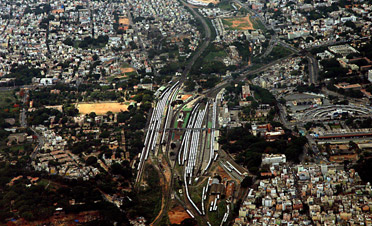Building Resilience through integrated water management in Bangalore, India

Bangalore, in southern India, has been rapidly growing over the past few decades from a population of 1.65 million in 1971 to approximately 8.5 million in 2011. Despite many economic gains in Bangalore, the city suffers from chronic shortages of basic services such as energy and water and severe traffic problems. In addition, the natural environment in and around Bangalore has been degraded, reducing the ecological sustainability and foundation for resilience in the city.
Priority Areas for Intervention
Water resources are a major concern for the continuously expanding city of Bangalore. Constraining the ability to properly plan for water services was limited by a lack of knowledge about the quantity of water being utilized. There was a data gap for both the demand side - in terms of what urban residents use and what they need. Marginal price information is not available to Bangalore residents and thus price signals do not alter water consumption behaviour. There was also a lack of detailed assessments in terms of water supply. Although it was known that the public utility water supply is drawn from the Cauvery River, which is 100km away from Bangalore, the city is already withdrawing its full legal limit. This public water supply is currently covering less than 50% of demand, so groundwater is also being utilized and there was no detailed understanding of groundwater levels, recharge-discharge dynamics, or safe yields. The lack of assessment of groundwater has also meant that policies on groundwater are non-existent or ill-informed.
Examples of Resilience Building Efforts
The Bangalore Urban Metabolism Project is an innovative project, supported by the Cities Alliance and implemented by the Stockholm Environment Institute, to utilize metabolism frameworks for understanding cities and designing more sustainable futures. Specifically, this framework has been designed to improve Integrated Water Resource Management in Bangalore based on multi-disciplinary perspectives and expertise, from hydrology, social science, economics, engineering and computer science.
The project has worked to address the challenges related to improving access to water and building resiliency highlighted in the section above. In order to increase data and understanding of the demand-side for water resources, the project has analysed the domestic water demand through surveys which showed that the urban poor are paying significantly more for water of inferior quality.
Utilizing a grid-based sampling design, the project has mapped groundwater and utilized both 1-D and 2-D models to better understand the availability of groundwater in Bangalore.
Consultations from the neighbourhood to national scale have been critical for raising awareness and understanding the diverse perspectives of stakeholders so this has been integrated throughout the project.
The culmination of this work will be an Integrated Water Resource Model that will support more sustainable planning and management for water resources that can both meet the needs of the urban poor and support the conservation of critical freshwater ecosystems.
